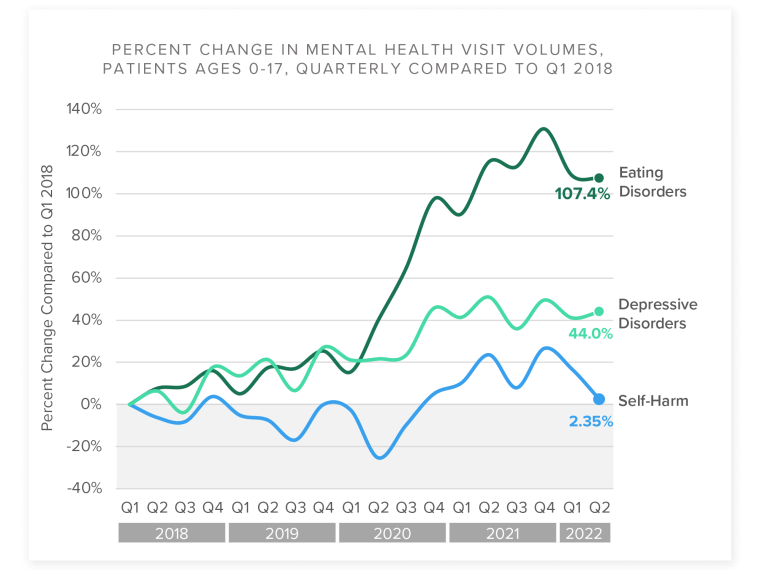Adolescent eating disorders are experiencing an unprecedented surge in prevalence and severity. Hospitalizations for eating disorders doubled among adolescent girls during the pandemic.
According to the Centers for Disease Control and Prevention, eating disorders, particularly anorexia still persist at all-time highs despite most teens returning to in-person activities.
Experts warn that the situation is alarming, and patients coming in with eating disorders are in more severe physical and mental conditions.
Looking at the Numbers
From 2018 through mid-2022, eating disorder-related visits among those younger than 17 increased by 107.4% for all eating disorders and 129.26% for anorexia nervosa, which is the mental illness with the highest death rate.

PC: Trilliant Health
According to a report by Trilliant Health, eating disorder-related health visits include hospital stays, paediatrician visits, telehealth talk therapy, and everything in between.
Also Read:
Here’s How Women are Countering Sexual Harassment with Safety Pins
Pandemic’s Impact
The pandemic’s incidence of anxiety and depression, both risk factors for triggering or worsening eating disorders, has worsened, and even after Covid, many adolescents and younger teens are struggling with the after-effects of the pandemic, such as losing touch with friends, falling behind in school, or grieving for family members who have died.
Trauma from the pandemic is collective, but many of these teens are experiencing PTSD, and they are younger. As a result, waitlists for eating disorders treatment have grown longer, with some people waiting months to begin treatment.
Despite the common eating disorder stereotype of being white, female, and underweight, research indicates that teens from racial and ethnic minority groups, as well as males and teens with larger bodies, are developing certain eating disorders at higher rates.
Eating disorders are less likely to be recognized among underrepresented groups, and eating disorder specialists may not accept Medicaid or insurance, making treatment access even more difficult for underrepresented minority groups, especially Black and Hispanic populations.
Is Binge Eating a Disorder?
American Psychiatric Association in its manual of mental disorders — the Diagnostic and Statistical Manual of Mental Disorders (DSM-5)— included binge eating as an official eating disorder for the first time.
The DSM.-5 omitted a requirement that people lose their periods to be diagnosed with anorexia, and included “atypical anorexia” for people with anorexia who aren’t technically low weight. This included a broad number of people.
“With the broadening criteria, we were able to be more aware that males can have eating disorders, specifically anorexia, and that people who live in larger bodies can also develop anorexia. So there’s definitely been better recognition and better acceptance,” Said Lin.
“Eating disorder care is significantly harder to access right now because of the increase in volume, and that’s where we’re stuck,” Lin said.
“For these teens to recover, they need to get into treatment as soon as possible, and we’re still a long way away from having enough providers to help the number of patients we have.”
Inadequate research studies into eating disorder disparities and missed diagnoses and treatment access barriers mean that the situation is dire. Some studies suggest that bulimia is more common among Hispanic teens than White teens, while binge-eating disorder is more common among both Black and Hispanic teens than White teens.
Before the pandemic, experts often began treating patients around the time of a parent’s divorce, a lost loved one, or the transition from middle school to high school or high school to college. Eating disorders are a complicated process involving biological, psychological, genetic, and social-cultural factors.
Under normal circumstances, strong social connections can act as protective factors for teens with heightened risks, helping them avoid developing eating disorders.
However, pandemic lockdowns suddenly cut young people off from these connections, and the environment pulls the trigger, making it harder for at-risk teens to access the protective factors they need to avoid developing eating disorders.
Also Read:
Pakistan’s Leading Psychiatrist Dr Ayesha Mian Talks About COVID, the Impact of Social Media, Eating Disorders, & Parenting
Different Forms of Eating Disorders
Various forms of eating disorders exist, including anorexia, bulimia, binge eating, and avoidant/restrictive food intake disorder (ARFID).
Anorexia
Anorexia is a disorder where individuals intentionally eat very little, resulting in very low body weight. They are afraid of weight gain and having a fat appearance, and they have a distorted perception of their body.
They may be extremely careful about what and how much they eat, with food or calorie intake on their minds constantly. Some people with anorexia may fast or exercise excessively, while others may use laxatives, diuretics, or enemas to lose weight.
Bulimia
Bulimia is a disorder where individuals overeat and feel unable to stop, known as binge eating. They take action to counteract their overeating, such as inducing vomiting after binge eating, using laxatives, diuretics, weight loss pills, fasting, or excessive exercise to prevent weight gain.
They base their self-worth on their body shape and weight. People with bulimia eat much more than usual during a set period of time. Those with bulimia may have a low, average, or high weight, unlike those with anorexia, who tend to be underweight. People with bulimia often conceal their eating and purging habits from others.
Binge Eating Disorder
Binge eating disorder is a condition where individuals overeat and feel unable to stop. They eat large quantities of food, even when they are not hungry. They may feel guilty or upset after binge eating and are likely to gain weight, sometimes becoming obese.
People with this disorder often eat faster than average and prefer to eat alone to avoid being judged for their consumption. They do not counteract their overeating by vomiting, using laxatives, or excessive exercise, as those with bulimia do. Binge eating disorder is typically characterized by binge eating at least once a week for three months.
ARFID
ARFID is a condition where individuals avoid eating due to the smell, taste, texture, or colour of food. They may also fear choking or vomiting. People with ARFID do not have a negative body image, fear gaining weight, or engage in weight loss behaviours, unlike those with anorexia and bulimia. They may lose weight or not gain weight as expected. ARFID is not due to any underlying medical condition or anorexia or bulimia.
There’s no one cause for eating disorders. Genes, environments, and stressful events all play a role. Some things can increase a person’s chance of having an eating disorder however this must be taken seriously by parents.
Have anything to add? Share your thoughts with us in the comments below.
Stay tuned to WOW360.
